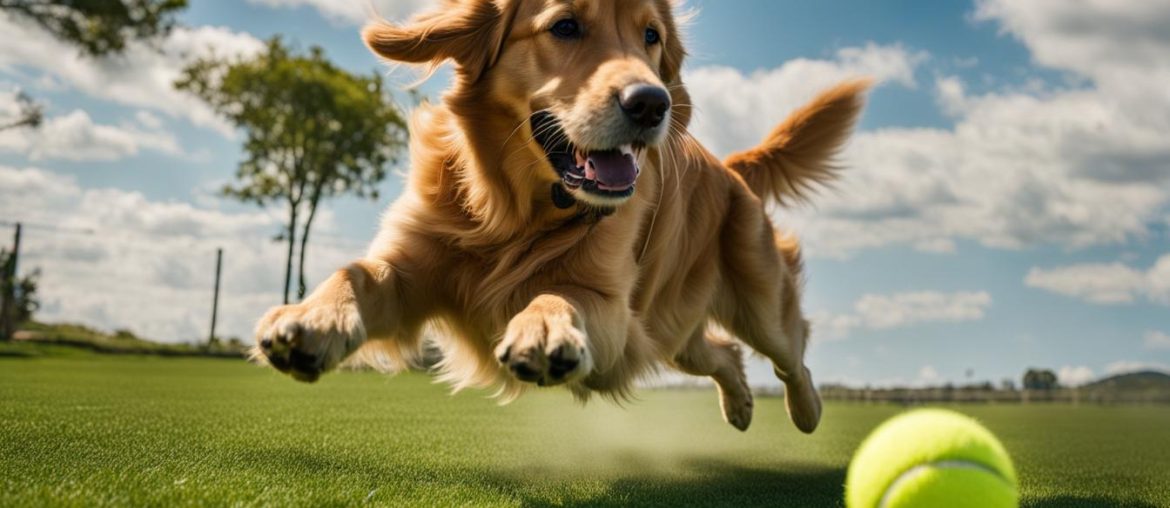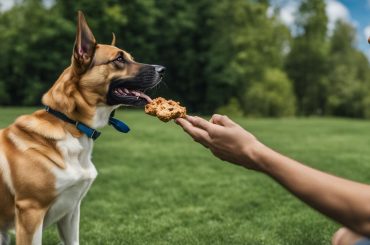Teaching a dog to fetch and retrieve can be a rewarding experience for both the dog and the owner. Not all dogs naturally know how to play fetch, but with the right training techniques, any dog can learn this fun and interactive game. Whether you’re looking to improve your dog’s obedience, engage in a bonding activity, or simply have some playtime, teaching fetch is a valuable skill to have.
Key Takeaways:
- Fetch is a game that can be taught to any dog with proper training techniques.
- Supplies needed for fetch training include a variety of toys, treats, and possibly a clicker.
- The first step in teaching fetch is teaching your dog to hold a toy.
- Once your dog has mastered holding, you can move on to teaching them to fetch.
- Positive reinforcement and patience are key to successful fetch training.
Supplies Needed to Teach Fetch
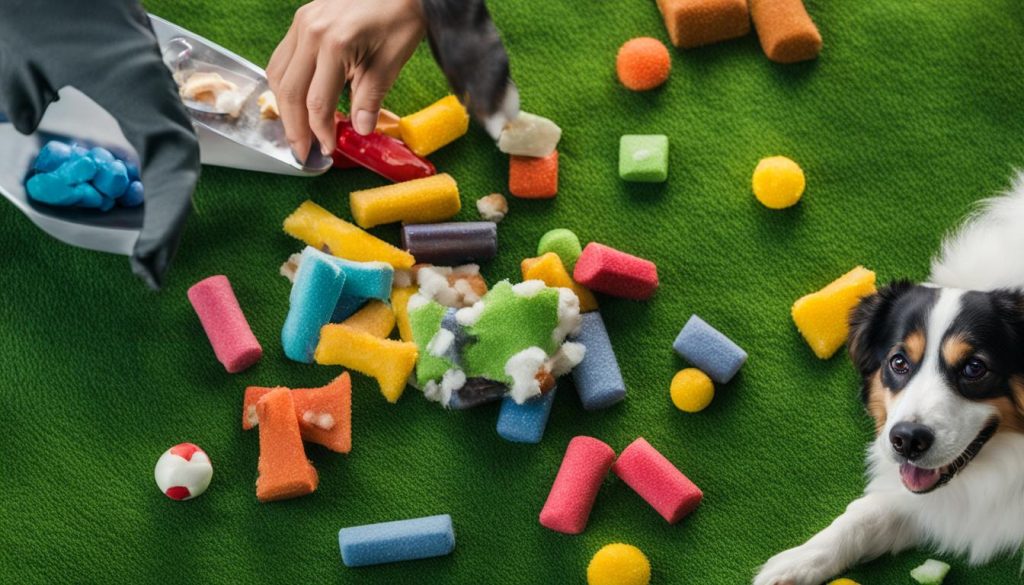
Teaching a dog to fetch requires a few essential supplies to ensure a successful training session. Here are the supplies you’ll need:
- Toys: Start by gathering a variety of toys to find out what kind your dog likes best. Experiment with different textures, shapes, and sizes to keep the training sessions interesting.
- Treats: Treats are an important tool in positive reinforcement training. Choose small, soft treats that your dog finds highly motivating.
- Clicker: While not necessary, a clicker can be a useful tool for clicker training. It helps to mark the desired behavior and allows for precise timing during the training process.
By having a selection of toys, treats, and a clicker, you’ll be well-equipped to teach your dog to fetch effectively.
Table: Supplies Needed to Teach Fetch
| Supplies | Description |
|---|---|
| Toys | A variety of toys to find out what kind your dog likes best |
| Treats | Small, soft treats that your dog finds highly motivating |
| Clicker | Optional tool for clicker training to mark desired behavior |
Step 1: Teaching Hold

Teaching a dog to fetch begins with the first step of teaching them to hold a toy. This step involves getting your dog comfortable with picking up and keeping a toy in their mouth. To start, show the toy to your dog and reward any interest or interaction with the toy. Gradually increase the criteria by waiting for your dog to sniff or touch the toy before giving them a reward. Once they consistently put their mouth on the toy, you can begin building duration by gradually increasing the time they are expected to hold it.
During this process, it’s important to use positive reinforcement and rewards to motivate your dog. You can also use a clicker if you are using clicker training. Remember to be patient and provide plenty of encouragement as your dog learns this new skill.
Step 2: Teaching Fetch
Now that your dog has mastered the “hold” command, it’s time to move on to teaching them how to fetch. This step focuses on getting your dog to take the toy from your hand and eventually retrieve it when thrown.
To start, hold the toy out to your dog in your outstretched palm and ask them to “hold.” If they take the toy, be sure to reward them with praise or a treat. If your dog doesn’t take the toy right away, continue practicing the “hold” command until they are consistently taking the toy from your hand.
| Step | Action |
|---|---|
| 1 | Hold the toy out to your dog in your outstretched palm and ask them to “hold.” |
| 2 | Reward your dog if they take the toy from your hand. |
| 3 | If your dog doesn’t take the toy, continue practicing the “hold” command. |
Once your dog is consistently taking the toy from your hand, you can begin to transition to throwing the toy and having them retrieve it. Start by placing the toy on the floor and asking your dog to “hold” it. When they pick it up, reward them with praise or a treat. Gradually increase the distance you throw the toy, always rewarding your dog when they retrieve it.
Consistency is key during this step of the training process. Make sure to use the same commands and rewards every time. Remember to be patient and give your dog plenty of encouragement and positive reinforcement. With practice, your dog will learn to fetch and retrieve with enthusiasm.
Tips for Successful Fetch Training

When teaching your dog to fetch, it’s important to approach the training with patience and a positive mindset. Here are some tips to help you have a successful fetch training session:
- Start in a small, enclosed space: Begin training in a quiet and confined area to minimize distractions. This will help your dog focus on the task at hand and make it easier for them to understand the concept of bringing the toy back to you.
- Use positive reinforcement: Reward your dog with treats, praise, and affection when they bring the toy back to you. This will create a positive association with the fetch behavior and motivate your dog to continue retrieving.
- Gradually increase the difficulty: Once your dog is comfortable fetching in a small space, try gradually increasing the distance you throw the toy. This will challenge your dog and help them develop their fetching skills further.
- Vary the toys: Dogs can get bored easily, so make sure to use a variety of toys during training sessions. Different types of toys, such as balls, ropes, or frisbees, can add excitement and keep your dog engaged in the game of fetch.
- Keep training sessions short and frequent: Dogs have a shorter attention span, so it’s best to keep each training session short and focused. Aim for multiple short sessions throughout the day rather than one long session.
Remember, each dog is unique and may progress at their own pace. Be patient and flexible in your approach, and adjust the training techniques to suit your dog’s individual needs and preferences.
By following these tips, you can create a positive and enjoyable fetch training experience for both you and your dog. With consistent practice and reinforcement, your dog will soon master the art of fetch and retrieval.
| Tip | Description |
|---|---|
| Start in a small, enclosed space | Begin training in a quiet and confined area to minimize distractions. This will help your dog focus on the task at hand and make it easier for them to understand the concept of bringing the toy back to you. |
| Use positive reinforcement | Reward your dog with treats, praise, and affection when they bring the toy back to you. This will create a positive association with the fetch behavior and motivate your dog to continue retrieving. |
| Gradually increase the difficulty | Once your dog is comfortable fetching in a small space, try gradually increasing the distance you throw the toy. This will challenge your dog and help them develop their fetching skills further. |
| Vary the toys | Dogs can get bored easily, so make sure to use a variety of toys during training sessions. Different types of toys, such as balls, ropes, or frisbees, can add excitement and keep your dog engaged in the game of fetch. |
| Keep training sessions short and frequent | Dogs have a shorter attention span, so it’s best to keep each training session short and focused. Aim for multiple short sessions throughout the day rather than one long session. |
Remember, each dog is unique and may progress at their own pace. Be patient and flexible in your approach, and adjust the training techniques to suit your dog’s individual needs and preferences.
Troubleshooting the Retrieve Behavior
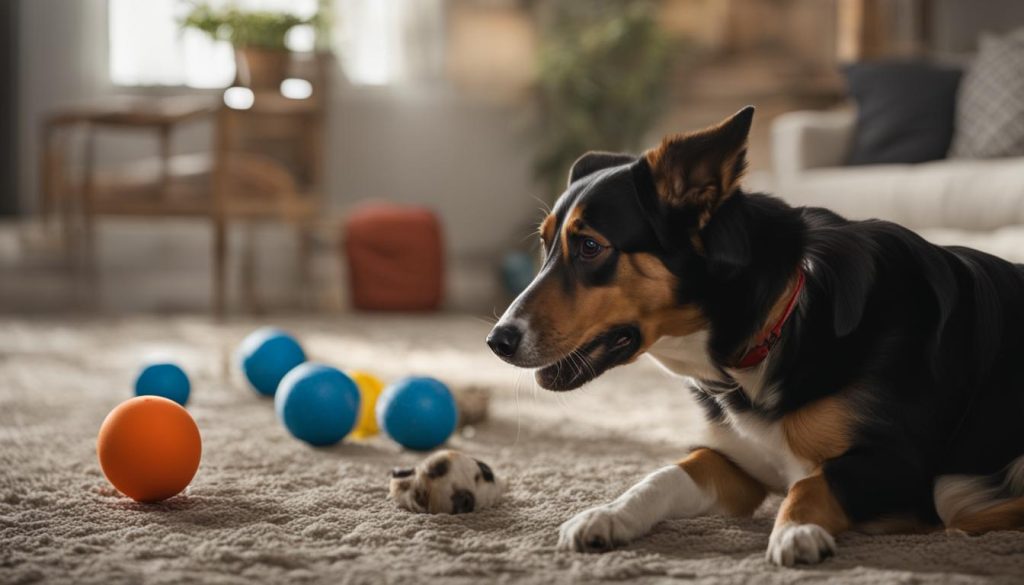
Teaching a dog to fetch and retrieve toys can sometimes come with challenges. Some dogs may struggle with certain aspects of the retrieve behavior, such as not bringing the toy back or dropping it prematurely. In this section, I will address some common issues that dog owners may encounter during fetch training and provide troubleshooting tips to overcome them.
One common issue is when a dog doesn’t bring the toy back after retrieving it. To address this, it’s important to teach the “drop it” command. Start by offering a high-value treat in exchange for the toy. As your dog drops the toy, use the command and reward them with the treat. Repeat this exercise consistently to reinforce the desired behavior.
Another issue could be when a dog enjoys playing keep-away instead of bringing the toy back. In this case, it’s best to avoid chasing after your dog. Instead, end the game if they don’t bring the toy back. By not engaging in the chase, you’re removing the reward for keep-away behavior and conveying that bringing the toy back is necessary to continue the game.
Remember to be patient and consistent in your training efforts. Each dog is unique, and it may take time for them to fully grasp the retrieve behavior. By using positive reinforcement, rewards, and consistent repetition, you can troubleshoot any issues and help your dog become a fetch pro.
Table: Common Fetch Training Troubleshooting
| Issue | Troubleshooting Tip |
|---|---|
| Dog doesn’t bring the toy back | Teach the “drop it” command and reward for returning the toy |
| Dog enjoys keep-away | Avoid chasing and end the game if they don’t bring the toy back |
| Dog drops the toy prematurely | Work on building duration and reiterate the “drop it” command |
| Dog loses interest in the toy | Try different types of toys and reward your dog for interacting with them |
By addressing these common issues that may arise during fetch training, you can overcome challenges and guide your dog towards becoming a proficient retriever. Remember to be patient, use positive reinforcement techniques, and adjust the training methods to suit your dog’s individual needs and preferences.
Alternative Games and Activities
While fetch may not be every dog’s cup of tea, there are plenty of alternative games and activities that can provide both mental stimulation and physical exercise for your furry friend. These activities can help keep your dog entertained and engaged, especially if they don’t show much interest in traditional fetch.
Scent Training
Scent training is an excellent way to challenge your dog’s sense of smell. You can hide treats or toys around your house or yard and encourage your dog to sniff them out. Not only is this game mentally stimulating, but it also taps into your dog’s natural instincts.
Agility Training
If your dog is active and loves to run, agility training can be a great option. Set up an obstacle course in your backyard using tunnels, jumps, and weave poles. This activity helps improve your dog’s coordination, speed, and overall fitness.
Interactive Toys and Food Puzzles
Interactive toys and food puzzles are a fantastic way to keep your dog mentally engaged. These toys are designed to challenge your dog’s problem-solving skills and provide entertainment while rewarding them with treats or food as they solve the puzzle.
Outdoor Activities
Exploring the great outdoors with your dog is always a good idea. Going for hikes or long walks not only provides physical exercise but also allows your dog to experience different scents and environments. You can also try engaging in nose work activities, where your dog searches for specific scents or objects, providing mental stimulation and a sense of accomplishment.
| Activity | Description |
|---|---|
| Scent Training | Hide treats or toys for your dog to sniff out |
| Agility Training | Set up an obstacle course for your dog to navigate |
| Interactive Toys and Food Puzzles | Challenge your dog’s problem-solving skills with interactive toys and puzzles |
| Outdoor Activities | Go for hikes or engage in nose work activities |
Remember, every dog is unique, so it’s essential to find activities that suit your dog’s preferences and abilities. By incorporating these alternative games and activities into your dog’s routine, you can ensure they stay mentally and physically stimulated, leading to a happier and healthier pup.
Importance of Mental Stimulation
When it comes to dog training, many people focus primarily on physical exercise. However, mental stimulation is just as important for a dog’s overall well-being. Engaging your dog’s mind through activities like fetch can help prevent boredom and behavior problems.
Dogs are intelligent animals that thrive on mental challenges. Teaching them new tricks, such as fetch and retrieve, not only stimulates their brains but also enhances their problem-solving skills and cognitive abilities. By incorporating mental stimulation into their daily routine, you can provide a fulfilling and enriching experience for your furry friend.
One way to mentally stimulate your dog during fetch training is to introduce variation and complexity into the game. You can change the location where you play fetch, use different types of toys, or add obstacles to increase the level of difficulty. These challenges will keep your dog engaged and mentally sharp, making the training sessions more rewarding for both of you.
| Mental Stimulation Benefits | Behavioral Improvements |
|---|---|
| Mental stimulation prevents boredom and reduces destructive behavior. | Regular mental stimulation can help reduce anxiety and aggression in dogs. |
| Engaging your dog’s mind can improve their focus and impulse control. | Dogs who receive mental stimulation are less likely to engage in problematic behaviors, such as excessive barking or chewing. |
| Mental stimulation can strengthen the bond between you and your dog as you work together on training exercises. | Training games like fetch encourage positive reinforcement, leading to a more obedient and well-behaved dog. |
Remember, mental stimulation should be a regular part of your dog’s routine, along with physical exercise. By providing both physical and mental challenges, you can help your dog lead a happier, healthier, and more well-rounded life.
The Benefits of Fetch Training

Fetch training is a valuable skill that brings numerous benefits to both dogs and their owners. By teaching your dog to fetch, you can provide them with physical exercise, mental stimulation, and an opportunity to strengthen the bond between you. It’s not just a fun game; it’s also a way to train obedience, improve impulse control, and enhance overall behavior.
One of the primary benefits of fetch training is the physical exercise it provides. When dogs engage in fetch, they run, jump, and retrieve the toy, which helps to burn off excess energy and keep them physically fit. Regular exercise can prevent obesity, promote cardiovascular health, and reduce the risk of various health issues.
Fetch training also offers mental stimulation for dogs. It challenges their minds as they learn to follow commands, identify and retrieve the toy, and wait patiently for their turn. Mental stimulation is essential for a dog’s overall well-being and can prevent boredom, behavioral problems, and destructive behaviors caused by excessive energy and lack of mental engagement.
Additionally, fetch training strengthens the bond between dogs and their owners. Dogs see their owners as providers of fun and rewarding activities, and playing fetch together builds trust and creates positive associations. It also helps to establish a clear communication system between you and your dog, as they learn to respond to commands and cues during the training sessions.
Summary:
- Fetch training provides physical exercise, mental stimulation, and strengthens the bond between dogs and their owners.
- Physical exercise during fetch helps to prevent obesity, promote cardiovascular health, and reduce the risk of health issues.
- Mental stimulation from fetch training prevents boredom, behavioral problems, and destructive behaviors.
- Playing fetch together strengthens the bond between dogs and their owners and establishes clear communication.
Tips for Successful Training Sessions
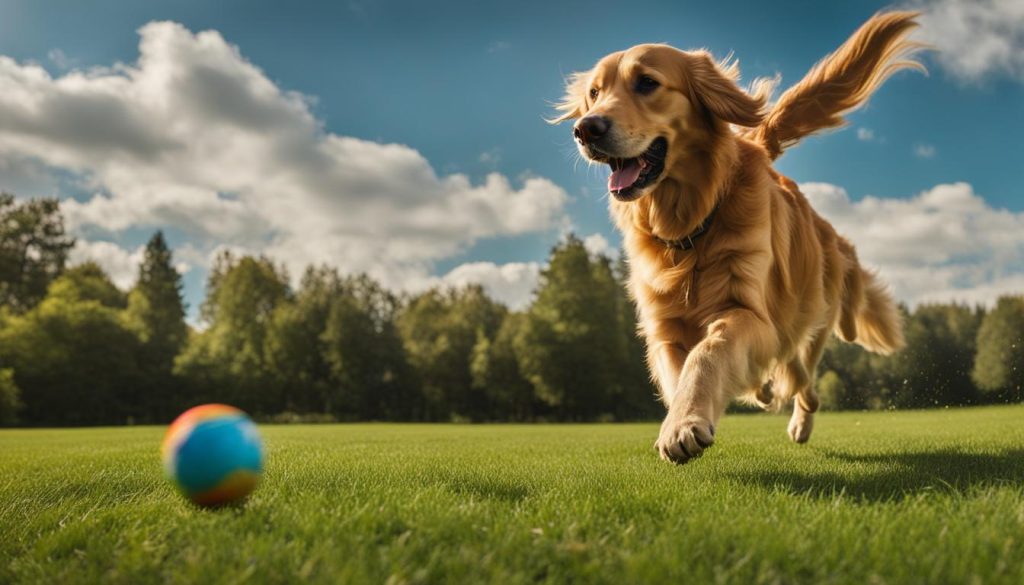
When it comes to teaching your dog to fetch, successful training sessions are key to achieving your goals. Here are some tips to ensure your sessions are effective and enjoyable for both you and your furry friend.
1. Create a Positive and Encouraging Environment
Positive reinforcement is essential when training your dog. Use treats, praise, and play as rewards for desired behaviors like picking up the toy and bringing it back to you. Make sure to celebrate your dog’s successes and provide plenty of encouragement throughout the training process.
2. Keep Training Sessions Short and Frequent
Dogs have shorter attention spans, so it’s important to keep training sessions brief. Aim for 5-10 minutes of focused training at a time. Schedule multiple sessions throughout the day to reinforce what your dog has learned and prevent them from becoming bored or fatigued.
3. Be Patient and Persistent
Teaching your dog to fetch may take some time and repetition. Be patient with your dog as they learn and be consistent in your training efforts. Stay persistent and don’t give up if your dog doesn’t grasp the concept right away. With consistency and positive reinforcement, they will eventually understand what you’re asking them to do.
Remember, every dog is unique, and the training process may vary from one dog to another. Tailor your training sessions to your dog’s individual needs and preferences. By creating a positive, encouraging environment, keeping sessions short and frequent, and being patient and persistent, you’ll set your dog up for success in learning the game of fetch.
Wrapping Up
Teaching a dog to fetch can be a rewarding experience for both you and your canine companion. By using positive reinforcement and consistent training techniques, any dog can learn to enjoy playing fetch and retrieve. Remember to be patient and tailor the training to your dog’s individual needs and preferences.
Throughout this article, we have discussed the importance of supplies needed for fetch training, the step-by-step process of teaching hold and fetch commands, as well as tips for successful training sessions. It’s crucial to go at your dog’s pace, be patient, and create a positive and encouraging environment during training.
Not all dogs may show interest in playing fetch, but there are plenty of alternative games and activities that can provide mental stimulation and physical exercise. Scent training, agility training, and interactive toys or food puzzles are just a few examples. Remember that mental stimulation is essential for your dog’s overall well-being.
So, whether you have a puppy learning their first commands or an older dog looking to learn new tricks, teaching your dog to fetch can strengthen your bond and provide countless benefits. Enjoy the journey of training your furry friend, and remember to have fun along the way!
FAQ
What supplies do I need to teach fetch?
To teach fetch, you will need a variety of toys to find out what kind your dog likes best. It’s also helpful to have treats for training and a clicker if you use clicker training. Different types of toys, such as balls or plush toys, can be used to vary the training experience.
How do I teach my dog to hold?
Teaching your dog to hold involves getting them comfortable with picking up and keeping a toy in their mouth. Start by showing the toy to your dog and rewarding any interest or interaction with the toy. Gradually increase the criteria by waiting for your dog to sniff or touch the toy before rewarding them. Once they consistently put their mouth on the toy, you can start building duration by gradually increasing the time they are expected to hold it.
How do I teach my dog to fetch?
Once your dog has mastered the “hold” command, you can move on to teaching them to fetch. Start by holding the toy out to your dog in your outstretched palm and asking them to “hold.” If they take the toy, reward them. If not, continue practicing the “hold” command. Once they are consistently taking the toy from your hand, place it on the floor and ask them to “hold” it. When they pick it up, reward them. Gradually increase the distance you throw the toy and continue rewarding your dog for retrieving it.
How can I make fetch training successful?
To make fetch training successful, it’s important to go at your dog’s pace and be patient. Start in a small, enclosed space to minimize distractions and gradually increase the difficulty by throwing the toy further away. Use positive reinforcement and rewards to keep your dog motivated and engaged. Vary the types of toys you use and continue to practice the “hold” and “fetch” commands in different locations and situations.
What do I do if my dog doesn’t bring the toy back?
If your dog doesn’t bring the toy back, focus on teaching the “drop it” command and reinforcing the desired behavior with rewards. If your dog enjoys playing keep-away, avoid chasing them and instead end the game if they don’t bring the toy back. It’s important to be consistent in your training and continue to reinforce the fetch behavior.
What are some alternative games and activities I can try if my dog doesn’t enjoy fetch?
If your dog doesn’t show much interest in fetch, there are plenty of alternative games and activities you can try. Scent training, agility training, and interactive toys or food puzzles can provide mental stimulation and physical exercise for your dog. Going for hikes, playing tug, or engaging in nose work can also be enjoyable activities for your dog.
Why is mental stimulation important for dogs?
Providing dogs with mental stimulation is crucial for their overall well-being. Activities like fetch and other training games challenge their minds and help prevent boredom and behavior problems. Mental stimulation can be just as important as physical exercise, so it’s essential to incorporate both into your dog’s routine.
What are the benefits of fetch training?
Fetch training has several benefits for both dogs and their owners. It provides physical exercise, mental stimulation, and strengthens the bond between the dog and the owner. It’s also a fun and engaging activity that can be enjoyed by dogs of all ages and breeds. Fetch training can help with obedience, impulse control, and overall behavior.
How can I have successful training sessions when teaching my dog to fetch?
To have successful training sessions when teaching your dog to fetch, it’s important to create a positive and encouraging environment. Use rewards and praise to motivate and reinforce desired behaviors. Keep training sessions short and frequent to maintain your dog’s attention and avoid fatigue. Consistency is key, so be patient and persistent in your training efforts.


